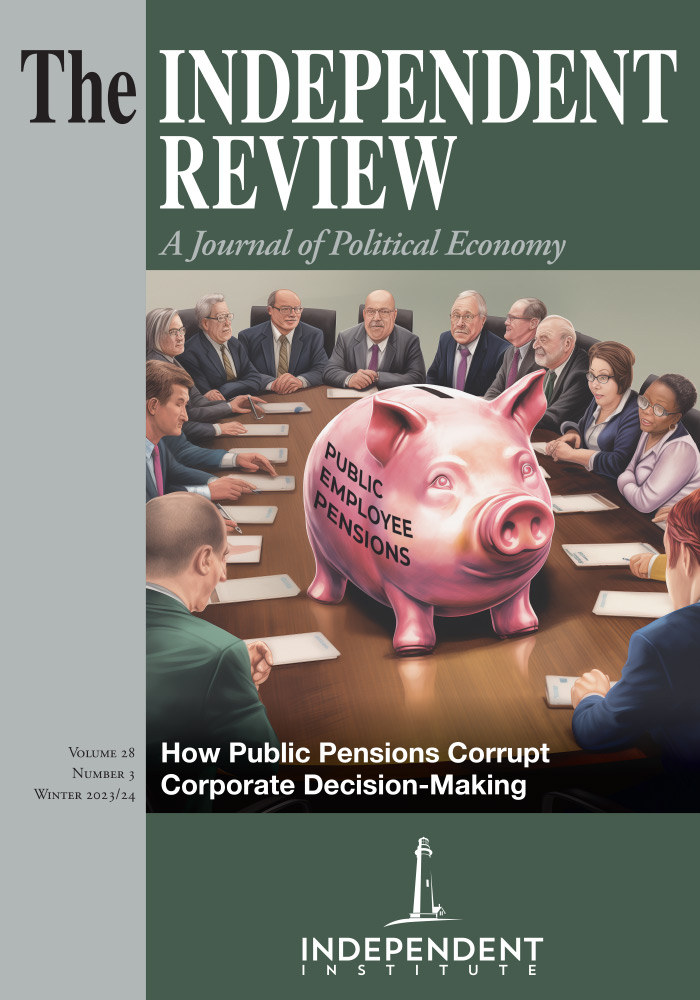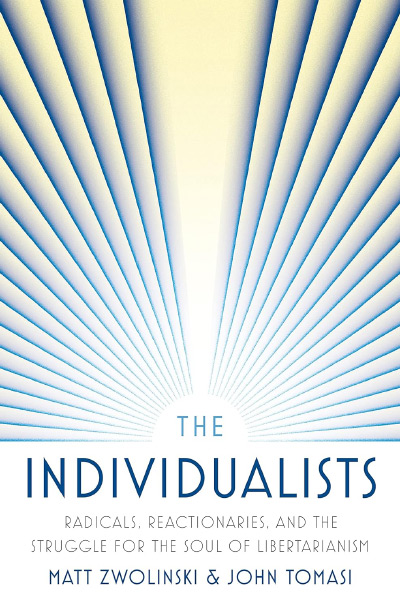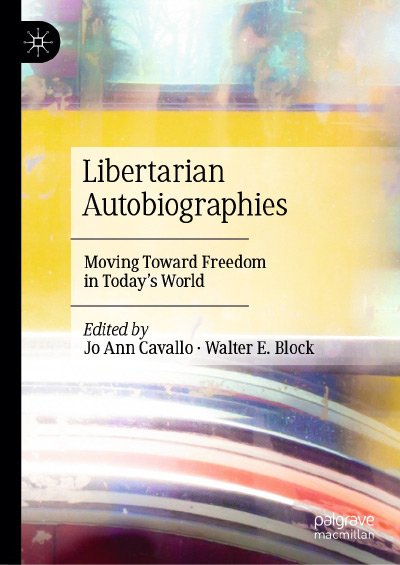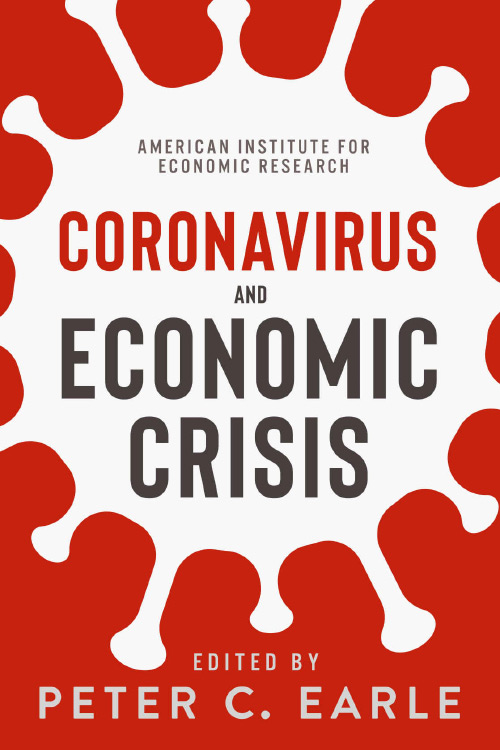The Individualists is a work of academic philosophy at once remarkably ambitious and highly accessible. Seasoned academics and general audiences will find much to enjoy in this crisply written, stimulating survey of the history of libertarian thought.
Matt Zwolinski and John Tomasi present their work as an “intellectual history” (p. 5). Both parts of this description are informative. Happily, The Individualists is not just another competitor in the already glutted market of political philosophy primers. Instead, it is a history, bringing to life the events and personalities behind the big ideas in just enough detail to contextualize the core themes. The result is a refreshing and vivid overview of libertarian political theory.
As good philosophers, Zwolinski and Tomasi start with definitions. In chapter 1, titled “What is Libertarianism?” Zwolinski and Tomasi attempt to characterize libertarianism. Although any attempt to define libertarianism will upset someone, the authors aim to be inclusive. They define libertarianism as a “family” of theories centered on a commitment to six key ideas: (1) property rights, (2) negative liberty, (3) individualism, (4) free markets, (5) skepticism about authority (especially state authority), and (6) the value and ubiquity of spontaneous order (chap. 1, pp. 20–21).
According to Zwolinski and Tomasi, all schools of libertarianism are united by a similar (though not identical) understanding about the importance of these six ideas. The authors analogize libertarianism to a family: You can see the resemblance among members, although each member is unique, in some cases maybe even a little eccentric. (Of course, accounting for eccentricity is crucial when your topic is libertarians.)
This flexible definition is useful since a primary goal of The Individualists is to introduce readers to the underacknowledged richness of libertarian thought. When you think of libertarianism, you probably jump to a few big names: Friedrich Hayek, Milton Friedman, Ludwig von Mises, Murray Rothbard, Ayn Rand. As the authors explain, this represents only one prominent strand of libertarianism, what they refer to as “Cold War libertarianism,” which focused largely on issues touching economic liberty (p. 2).
But The Individualists aims to give equal attention to less prominent schools, times, and places, such as the homegrown libertarian abolitionism of the nineteenth-century United States, left-wing strands of libertarianism including libertarian anarchists and socialists, and progressive varieties of libertarianism emphasizing social issues and the potential benefits of government, e.g., contemporary “bleeding heart” libertarianism or “state capacity” libertarianism. This sweeping history is covered in chapter 2. Apart from the most familiar names, characters who receive sustained attention include Lysander Spooner, Henry George, Herbert Spencer, Gustave de Molinari, Josiah Warren, Benjamin Tucker, and Albert Jay Nock. The Individualists is organized broadly along the lines of the “six key concepts” mentioned above. Following an introduction and the two preliminary chapters, the authors take up the right of private property in chapter 3, titled “Land, Labor, and Ownership.” This chapter is emblematic of the authors’ eclectic approach, which often juxtaposes the “right”-libertarian defenses of capitalism with radical, “left”-libertarian critiques of capitalism.
Fascinatingly, these two opposed lines of thought often start from the same Lockean premise: that the acquisition of private property is justified as a person’s rightful claim to the fruits of their own labor and creativity:
The labour of [one’s] body, and the work of his hands, we may say, are properly his. Whatsoever then he removes out of the state that nature hath provided, and left it in, he hath mixed his labour with, and joined to it something that is his own, and thereby makes it his property.” (John Locke, Second Treatise of Government, sec. 27)
Right-libertarians conclude from this principle that a legal-economic system enshrining property rights along the contours of our own is justified and defensible.
Left-libertarians, by contrast, view the Lockean principle as possessing radical implications. They argue that its strident application would lead us to view the current distribution of property as illegitimate, insofar as it is built on the frequent historical failures to respect property rights. Therefore, by the lights of the Lockean principle, contemporary property arrangements are mostly unjustified, and almost certainly demand rectification, perhaps even revolution. (Interestingly, as Zwolinski and Tomasi point out, this left-libertarian critique of capitalism takes on an even stronger flavor when combined with labor theories of value, which were popular among libertarian anarchists and socialists in the United States prior to the marginal revolution in economics.)
Other divisions are shown to emerge among libertarians regarding the legitimate kinds of property: Is “intellectual property” a valid institution? What about the private holding of land? Can I sell loans at interest? Can I sell myself ? Concerning these and other questions, a pattern emerges that is woven throughout the book: starting with the same basic idea, different schools of libertarianism come to widely disparate conclusions.
The other chapters show how in many contexts the six key ideas generate a variety of creative solutions to complex political puzzles. Chapter 4, on the state, analyzes libertarian thinking about government and political authority, ranging from more to less extreme responses. Chapter 5, on big business, clarifies some misconceptions about the relationship between libertarianism and corporate power. Chapter 6 considers several ways of thinking about poverty in light of markets and spontaneous order. Chapter 7 discusses libertarian approaches to race throughout history, from slavery to civil rights reform. Chapter 8—on free trade, free markets, and libertarian visions of the international realm—caps the book.
General readers will find Zwolinski and Tomasi’s treatment fascinating for its diverse coverage of thinkers and topics. At the same time, the authors, whose mastery of all matters libertarian is frequently displayed (not least by their copious footnotes), push forward the conversation even for academics already entrenched in libertarian scholarly debates. In what follows, I wish to highlight and query a few points of current interest raised by the authors.
Classical Liberalism vs. Strict Libertarianism
One striking feature of the book is the relatively sharp distinction Zwolinski and Tomasi draw between “strict” libertarianism and classical liberalism. The authors acknowledge that, in a broader sense, both of these schools can be considered “libertarian” by virtue of their shared participation in twentieth-century political movements. Still, according to the authors, libertarians, strictly speaking, differ from classical liberals not so much in their belief in the six key principles as in (a) the moral force libertarians attach to them as imperatives and (b) libertarians’ steadfastness in the principles’ application. In other words, for libertarians, the six key principles are closer to moral absolutes than general ideals, and they must be applied strictly, with the rarest of exceptions, and not merely as defeasible rules or guidelines.
In a sense, the hard distinction between libertarianism and classical liberalism is a taxonomic choice, and to that extent it is unobjectionable. After all, if there is no harm to others, one should be free to do as one pleases, including define one’s terms. Nevertheless, an apparent implication of the authors’ categorical scheme (perhaps a surprising one) is that, strictly speaking, libertarians will be in the same family as libertarian socialists, philosophical anarchists, minimal statists, and Georgists, but not in the same family as Adam Smith, David Hume, John Stuart Mill, and Friedrich Hayek.
The Radicalism of Libertarianism
Once again, to the extent this is a definitional decision, there is nothing intrinsically unacceptable about it. However, the choice to draw the distinction this way illustrates a broader motivation behind Zwolinski and Tomasi’s project. Throughout the book, the authors often take great pains to illustrate the progressive impulses of libtarianism, which they claim “emerg[ed] in the nineteenth century as an idealistic and progressive radicalization of classical liberalism” (p. 7).
While at no point in the book does it become oppressive, the authors make clear their ideological sympathies with “bleeding heart” libertarianism (pp. 8, 65) and their hopes to reframe libertarianism as a radical rather than a conservative force: libertarians are, or at least should be (and an important portion of them always has been), on the side of feminism, abolitionism, civil rights, organized labor, sexual freedom, technological progress, and liberal social causes.
To this extent, the authors take a side in current intralibertarian debates about what “side of history” libertarianism is really on. They join authors like Peter Boettke,who has argued in The Struggle for a Better World (2021, Arlington, Va.: Mercatus Center at George Mason University, 3) that
the liberal project . . . was born as an emancipation project—freeing individuals from subjugation by the Crown, from the dogma of the Altar, from the violence and oppression of the Sword, from the bondage of Slavery, from the miserable poverty of the Plough, and from the special privileges granted to the Mercantile Interests.
Even so, the authors’ stance only rarely colors their discussion of opposing views. For instance, their treatment of racial issues, perhaps the most hot-button issue of today, is especially admirable in its even-handedness, if occasionally flawed. One could do without the unsubstantiated labeling of some right-libertarians as racist (p. 335, n. 71), or the tendentious imputation to Murray Rothbard of “a relish for police brutality against Black people” (p. 244). Nevertheless, in typical fashion, Zwolinski and Tomasi manage to produce a largely unbiased discussion of libertarian approaches to racial justice that will evoke little anger from any side. To not provoke strong reactions on a highly polarized topic is an impressive achievement—doubly so for libertarians.
The Future of Libertarianism: Conservative or Progressive?
The Individualists’ intentional highlighting of the radical, progressive strands of libertarianism will help philosophers and political theorists assess the ideological realignments occurring today. As the authors argue, once the Cold War ended, the obvious alliance or “fusion” between libertarians and conservatives was no longer obvious: “When the Berlin Wall fell in 1989, libertarianism was thus thrown into an identity crisis” (p. 63).
That identity crisis persists, and today, as the intellectual Right finds itself increasingly sympathetic toward nationalism, state intervention, and industrial policy, libertarians are rightly asking which side of the partisan aisle is more ripe for a political coalition. The Individualists, while providing fair and ample coverage of right-libertarian views, consistently raises the question of whether socially liberal, radical, and progressive libertarianisms aren’t truer to libertarian principles. Libertarianism, if it is to remain a movement with any concrete political influence, will surely have to decide that question over the next decade.


















